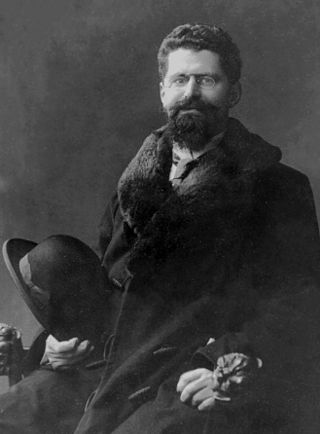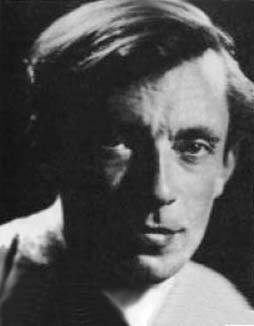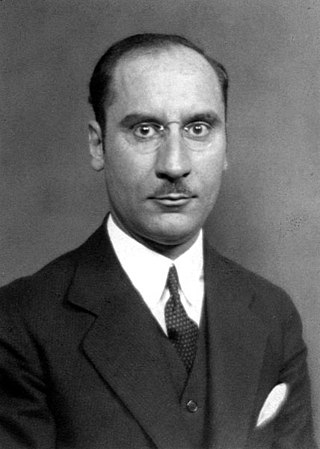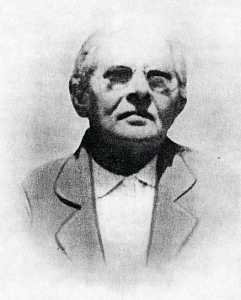Related Research Articles

Francesco Severi was an Italian mathematician. He was the chair of the committee on Fields Medal in 1936, at the first delivery.

Renato Caccioppoli was an Italian mathematician, known for his contributions to mathematical analysis, including the theory of functions of several complex variables, functional analysis, measure theory.

Guido Stampacchia was an Italian mathematician, known for his work on the theory of variational inequalities, the calculus of variation and the theory of elliptic partial differential equations.

Leonida Tonelli was an Italian mathematician, noted for proving Tonelli's theorem, a variation of Fubini's theorem, and for introducing semicontinuity methods as a common tool for the direct method in the calculus of variations.
Mauro Picone was an Italian mathematician. He is known for the Picone identity, the Sturm-Picone comparison theorem and being the founder of the Istituto per le Applicazioni del Calcolo, presently named after him, the first applied mathematics institute ever founded. He was also an outstanding teacher of mathematical analysis: some of the best Italian mathematicians were among his pupils.
Lamberto Cesari was an Italian mathematician naturalized in the United States, known for his work on the theory of surface area, the theory of functions of bounded variation, the theory of optimal control and on the stability theory of dynamical systems: in particular, by extending the concept of Tonelli plane variation, he succeeded in introducing the class of functions of bounded variation of several variables in its full generality.

Luigi Amoroso was an Italian neoclassical economist influenced by Vilfredo Pareto. He provided support for and influenced the economic policy during the fascist regime.

Gaetano Fichera was an Italian mathematician, working in mathematical analysis, linear elasticity, partial differential equations and several complex variables. He was born in Acireale, and died in Rome.

Antonio Signorini was an influential Italian mathematical physicist and civil engineer of the 20th century. He is known for his work in finite elasticity, thermoelasticity and for formulating the Signorini problem.

Enzo Martinelli was an Italian mathematician, working in the theory of functions of several complex variables: he is best known for his work on the theory of integral representations for holomorphic functions of several variables, notably for discovering the Bochner–Martinelli formula in 1938, and for his work in the theory of multi-dimensional residues.

Giovanni Battista Rizza, officially known as Giambattista Rizza, was an Italian mathematician, working in the fields of complex analysis of several variables and in differential geometry: he is known for his contribution to hypercomplex analysis, notably for extending Cauchy's integral theorem and Cauchy's integral formula to complex functions of a hypercomplex variable, the theory of pluriharmonic functions and for the introduction of the now called Rizza manifolds.
Federico Cafiero was an Italian mathematician known for his contributions in real analysis, measure and integration theory, and in the theory of ordinary differential equations. In particular, generalizing the Vitali convergence theorem, the Fichera convergence theorem and previous results of Vladimir Mikhailovich Dubrovskii, he proved a necessary and sufficient condition for the passage to the limit under the sign of integral: this result is, in some sense, definitive. In the field of ordinary differential equations, he studied existence and uniqueness problems under very general hypotheses for the left member of the given first-order equation, developing an important approximation method and proving a fundamental uniqueness theorem.
Maria Adelaide Sneider was an Italian mathematician working on numerical and mathematical analysis. She is known for her work on the theory of electrostatic capacities of non-smooth closed hypersurfaces: Apart from the development of precise estimates for the numerical approximation of the electrostatic capacity of the unit cube, this work also led her to give a rigorous proof of Green's identities for large classes of hypersurfaces with singularities, and later to develop an accurate mathematical analysis of the points effect. She is also known for her contributions to the Dirichlet problem for pluriharmonic functions on the unit sphere of

Alessandro Faedo was an Italian mathematician and politician, born in Chiampo. He is known for his work in numerical analysis, leading to the Faedo–Galerkin method: he was one of the pupils of Leonida Tonelli and, after his death, he succeeded him on the chair of mathematical analysis at the University of Pisa, becoming dean of the faculty of sciences and then rector and exerting a strong positive influence on the development of the university.

Luigi Amerio, was an Italian electrical engineer and mathematician. He is known for his work on almost periodic functions, on Laplace transforms in one and several dimensions, and on the theory of elliptic partial differential equations.

Pia Maria Nalli was an Italian mathematician known for her work on the summability of Fourier series, on Morera's theorem for analytic functions of several variables and for finding the solution to the Fredholm integral equation of the third kind for the first time. Her research interests ranged from algebraic geometry to functional analysis and tensor analysis; she was a speaker at the 1928 International Congress of Mathematicians.
Carlo Miranda was an Italian mathematician, working on mathematical analysis, theory of elliptic partial differential equations and complex analysis: he is known for giving the first proof of the Poincaré–Miranda theorem, for Miranda's theorem in complex analysis, and for writing an influential monograph in the theory of elliptic partial differential equations.
Gianfranco Cimmino was an Italian mathematician, working mathematical analysis, numerical analysis, and theory of elliptic partial differential equations: he is known for being the first mathematician generalizing in a weak sense the notion of boundary value in a boundary value problem, and for doing an influential work in numerical analysis.
In mathematics, and particularly in functional analysis, Fichera's existence principle is an existence and uniqueness theorem for solution of functional equations, proved by Gaetano Fichera in 1954. More precisely, given a general vector space V and two linear maps from it onto two Banach spaces, the principle states necessary and sufficient conditions for a linear transformation between the two dual Banach spaces to be invertible for every vector in V.
Paolo Emilio Ricci is an Italian mathematician, working on mathematical physics, orthogonal polynomials, special functions, numerical analysis, approximation theory and other related subjects mathematical analysis, theory of elliptic partial differential equations and special functions: he is also known for his work collaboration with Johan Gielis.
References
- Amerio, Luigi (1987), "Mauro Picone e l'Istituto per le Applicazioni del Calcolo", La Matematica Italiana tra le due guerre mondiali. Milano, Gargano del Garda, 8-11 ottobre 1986[Italian Mathematics between the two world wars. Milan, Gargano del Garda, 8–11 October 1986] (in Italian), pp. 15–23, ISBN 978-88-371-0409-2, MR 0985762, Zbl 0825.01008 . (English: Mauro Picone and the Institute for Calculus Applications) A survey paper on the contribution of Mauro Picone and his school to applied mathematics through the foundation and the direction of the "Istituto per le Applicazioni del Calcolo".
- Benzi, Michele (2005), "Gianfranco Cimmino's Contributions to Numerical Mathematics", in Pini, Bruno (ed.), Atti del Seminario di Analisi Matematica, Dipartimento di Matematica dell'Università di Bologna. Volume Speciale: Ciclo di Conferenze in Memoria di Gianfranco Cimmino, Marzo-Aprile 2004, Bologna: Tecnoprint, pp. 87–109. The preprint version of the original paper is downloadable from the author's academic web page Archived 2016-02-21 at the Wayback Machine .
- Benzi, Michele; Toscano, Elena (May 2014), "Mauro Picone, Sandro Faedo, and the Numerical Solution of Partial Differential Equations in Italy (1928–1953)", Numerical Algorithms , 66 (1): 105–145, CiteSeerX 10.1.1.379.2151 , doi:10.1007/s11075-013-9727-6, MR 3197360, Zbl 1291.01022 , previously published as Mauro Picone, Sandro Faedo, and the Numerical Solution of Partial Differential Equations in Italy (1928–1953) (PDF), Math/CS Technical Report, vol. TR-2013-003, March 2013, p. 33, archived from the original (PDF) on 2022-01-20, retrieved 2016-07-24.
- De Angelis, P. L.; Sbordone, C., eds. (1999), "Mauro Picone (1885–1977)", Matematici all'Istituto Universitario Navale (1926 – 1976)[Mathematicians at the Istituto Universitario Navale (1926 – 1976)] (in Italian), Napoli: Istituto Universitario Navale/RCE Edizioni, pp. 7–8. The chapter on Picone in a book collecting brief biographical sketches and bibliographies of the scientific works produced by the mathematicians who taught at the Parthenope University of Naples during their stay.
- Fichera, Gaetano (1950), "Risultati concernenti la risoluzione delle equazioni funzionali lineari dovuti all'Istituto Nazionale per le applicazioni del calcolo" [Results concerning the solutions of linear functional equations due to the National Institute for Calculus Applications], Atti della Accademia Nazionale dei Lincei. Memorie. Classe di Scienze Fisiche, Matematiche e Naturali, Serie VIII (in Italian), 3 (1): 1–81, MR 0036409, Zbl 0066.09902 . An ample survey paper on results on the solutions of linear integral and partial differential equation obtained by the research team of Mauro Picone at the Istituto Nazionale per le Applicazioni del Calcolo, by using methods from functional analysis.
- Fichera, Gaetano (1986), "Mauro Picone, un pioniere dell'analisi d'oggi", in Montalenti, G.; Amerio, L.; Acquaro, G.; Baiada, E.; et al. (eds.), Convegno celebrativo del centenario della nascita di Mauro Picone e Leonida Tonelli (Roma 6–9 May 1985) [International congress in occasion of the celebration of the centenary of birth of Mauro Picone and Leonida Tonelli (Rome 6–9 May 1985)], Atti dei Convegni Lincei (in Italian), vol. 77, Roma: Accademia Nazionale dei Lincei, pp. 75–88, archived from the original on 23 February 2011, retrieved 24 July 2016. "English: Mauro Picone, a pioneer of modern analysis" is an historical conference on the work and personality of Mauro Picone, pronounced by Gaetano Fichera.
- Fichera, Gaetano (1995), "L'ultima lezione" [The last lesson], Rendiconti della Accademia Nazionale delle Scienze Detta dei XL, Memorie di Matematica e Applicazioni (in Italian), 19 (1): 1–24, MR 1387547, archived from the original on 2011-07-26. Fichera's "last lesson" of the course of higher analysis, given on the occasion of his retirement from university teaching in 1992.
- Fichera, Gaetano (1999), "L'analisi matematica in Italia fra le due guerre" [Mathematical analysis in Italy between the two wars], Atti della Accademia Nazionale dei Lincei, Rendiconti Lincei, Matematica e Applicazioni, IX (in Italian), 10 (4): 279–312.
- Ghizzetti, Aldo (1986), "Mauro Picone e l'Istituto Nazionale per le Applicazioni del Calcolo", in Montalenti, G.; Amerio, L.; Acquaro, G.; Baiada, E.; et al. (eds.), Convegno celebrativo del centenario della nascita di Mauro Picone e Leonida Tonelli (6–9 maggio 1985), Atti dei Convegni Lincei (in Italian), vol. 77, Roma: Accademia Nazionale dei Lincei, pp. 111–116, archived from the original on 2011-02-23, retrieved 2016-07-24. "Mauro Picone and the Istituto Nazionale per le Applicazioni del Calcolo" is a brief historical survey of Picone's role in the founding of the Istituto Nazionale per le Applicazioni del Calcolo: the Author is one of his pupils, former workers and then director of the institute. It was presented at the International congress in occasion of the celebration of the centenary of birth of Mauro Picone and Leonida Tonelli (held in Rome on May 6–9, 1985): an English translation of the title of the conference is:-The work of Leonida Tonelli and his influence on scientific thinking in this century.
- Miranda, Carlo (July–December 1950), "Risultati concernenti la risoluzione delle equazioni funzionali lineari dovuti all'Istituto Nazionale per le Applicazioni del Calcolo" [Results regarding the solution of linear functional equations due to the National Institute for Calculus Applications], Rendiconti di Matematica e delle sue Applicazioni , 5 (in Italian), 9 (3–4): 346–353, MR 0041759, Zbl 0040.35304 . This work completes the survey of Fichera (1950) with the same title, by elucidating the role of some scientists and adding a further bibliography.